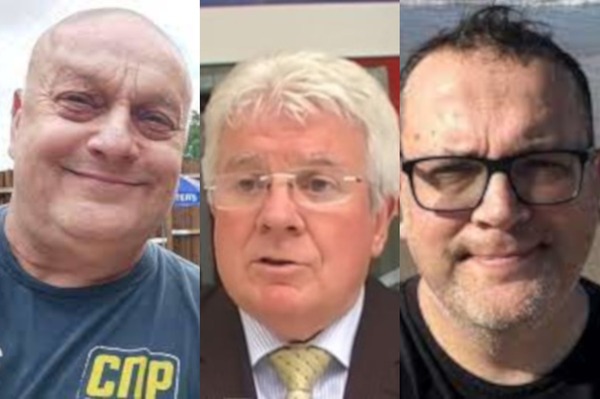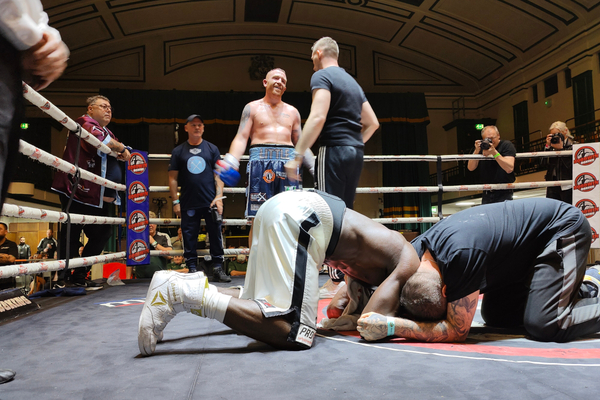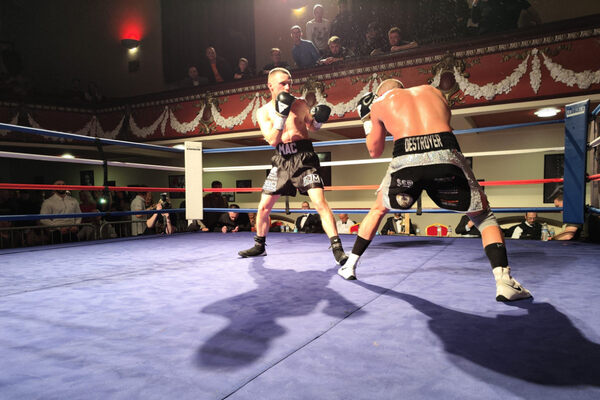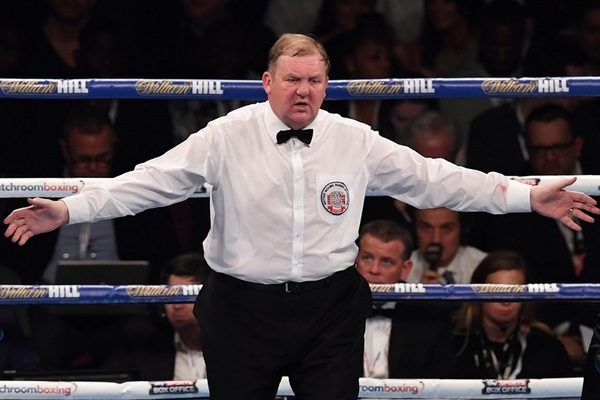Brener Zwikel are one of the best
There are very few companies in professional boxing that are known for decency and competence and are universally liked. Brener Zwikel & Associates is one of them.
Steve Brener was born in California in 1951. He started his career in public relations with the Los Angeles Dodgers in 1970 and, five years later, became the youngest publicity director in the history of Major League Baseball.
Brener left the Dodgers in 1987 to become director of communications for Hollywood Park. Then, in 1989, he got a telephone call from Bob Arum, who asked if he'd be willing to work on the rematch between Sugar Ray Leonard and Thomas Hearns.
"I'd always enjoyed boxing," Brener remembers. "And when I was with the Dodgers, I was close to Tom Lasorda and went to a lot of big fights with him. So the idea of working on Leonard-Hearns II appealed to me."
Brener helped publicize Leonard's final four fights. Meanwhile, he started his own business with a support staff that consisted of an office manager and one associate. In 1990, Toby Zwikel, whom he'd worked with at the Dodgers, joined him.
Brener Zwikel now has eighteen fulltime employees with offices in Reseda, Las Vegas, Jacksonville, and New York. Brener is president and Zwikel is vice president. The senior account executives are John Beyrooty, Dan Clavadetscher, Lisa Holby, Fred Robledo, Lara Potter, and Chris DeBlasio.
Thirty percent of BZA's work relates to fifteen golf tournaments that are contested annually on the PGA Tour. Auto racing, tennis, and the NFL Super Bowl each account for ten percent. The remaining forty percent of BZA's workload is boxing.
The choice of a public relations company to handle chores for a big fight is made by the network that televises the fight, the site, and the promoter. BZA gets all of Showtime's business and is the firm of choice for Don King Productions, the MGM Grand, and the Mirage.
As for what BZA does, Brener explains, "Once a fight is signed, the wheels move pretty quickly. We're given a budget to work with, and then we prepare a basic PR plan."
A lot of that plan revolves around time-honored templates, but there are always variables. And as Brener notes, "The media plan isn't the creation of one mind. It's many minds working together."
The basic chores that BZA performs for a big fight are:
(1) Preparation of a comprehensive media kit with fighter biographies, ring records, and other information regarding the participants.
(2) Coordinating the kick-off press conference and, sometimes, a media tour.
(3) Distribution of media releases, fact sheets, backgrounders, and other materials to newspaper, radio, television, Internet, and magazine reporters.
(4) Setting up periodic conference calls with the media.
(5) Consultation with regard to sponsorships and advertising.
(6) Event credentialing, which is a perpetual headache. By way of example, for the De La Hoya-Mosley rematch, there were seven hundred credentials requests.
(7) Operating the fight-week media center, which involves keeping seven or eight people on site from the Sunday preceding the fight through the post-fight press conference.
BZA has "snail mail" and email lists with more than five hundred names on each for boxing. "Obviously, you need good relationships with the media," says Brener. "But a lot of our job is building relationships and establishing a comfort level with the fighters and getting them to understand that we're on the same team. My best experience in boxing was working with Sugar Ray Leonard. He was a great fighter; he was promotable; and he always gave us the time we needed. Evander Holyfield is sensational to work with. Mike Tyson is a double-edged sword. The media is hungry for Tyson information, but Mike isn't comfortable doing PR and he doesn't always cooperate."
The part about Tyson not always cooperating is an understatement. On January 22, 2002, Brener was in New York for what he calls "a well-organized press conference in a nice little theatre" to announce Tyson versus Lennox Lewis. Then there was a problem. As Brener recalls, "It was, uh oh; here we go again."
Tyson blew off most media requests during the build-up to Lewis-Tyson. And although Tyson versus Clifford Etienne wasn't as big as Lewis-Tyson, it was equally bizarre. Regarding Iron Mike's last-minute tattoos and the like, Brener recalls, "We were on site and it was, 'The fight's off; the fight's on; the fight's off; no, it's on again; no, now it's off and that's final.' So I was in the airport," Brener continues, "waiting to get on a plane to go back to Los Angeles, when Marina Capurro called and told me, 'Surprise! It's on again.' The first thing I thought of was that we had a box of credentials at the hotel in Memphis that I hoped hadn't been picked up yet by Federal Express. I called the hotel and that was fine. Then I got my bags off the plane and went back to work."
Capurro (a Showtime vice president for communications) says of BZA, "I love those guys. I wouldn't trade them for the world." And Showtime boxing czar Jay Larkin adds, "Brener Zwikel is a mainstay of our boxing program. They're rock solid; they do everything well. If Steve Brener tells you that he's got something covered or a problem has been solved, you can put it out of your mind because you know it's done."
Alan Feldman (senior vice president of public affairs for the MGM Grand and Mirage) is equally complimentary. "Steve and Toby have forged a reputation for integrity and professionalism," says Feldman. "They understand that, at the end of the day, their job isn't about banners or food; it's about substance. We've used them since the Mirage opened in 1989, and they've always met our needs within the framework of the needs of the media. Not once has there been a time when either of them looked at his watch and complained about working at any hour of the day or night. In the business they're in, no one is better."
And Bob Goodman (director of boxing for Don King Productions) adds, "They're good people. Steve Brener is a pro's pro. You can always count on him to get things done. And he's got John Beyrooty."
That, of course, brings one to Beyrooty who, along with Dan Clavadetscher, works almost exclusively on boxing.
Beyrooty went to work for the Los Angeles Herald-Examiner as a copy boy in the 1970s and eventually began writing a weekly boxing column. When the Herald-Examiner folded, he got a job working for Jerry Buss in the PR department at The Forum. From there, he went to the Long Beach Press-Telegraph. Finally, as he puts it, he was "rescued by Brener Zwikel."
Beyrooty's most memorable moment on the job came just prior to Holyfield-Ruiz II, when Evander took note of his distinctive features and queried, "Who's that? He looks like Lucifer."
"Ever since then," Beyrooty says ruefully, "I've been known in some quarters as Satan."
Meanwhile, in a business marked by bad-mouthing and back-stabbing, everyone seems to have something nice to say about Brener Zwikel. And Brener says nice things in return. "I enjoy the personalities involved," he acknowledges, "the characters, and most of all, the electricity of a big fight. I started my career in public relations working with Tom Lasorda, who was one of the greatest promoters of all time. Now I'm working with Don King, who's possibly the greatest promoter in history. Who else but Don could do the things he does? Putting eight championship fights on a single card. Promoting Julio Cesar Chavez against Greg Haugen in Mexico City in front of 120,000 people. When I look back over the opportunities I've had, I have to say, I've been blessed."
Award winning author Thomas Hauser can be reached at
thauser@rcn.com
Steve Brener was born in California in 1951. He started his career in public relations with the Los Angeles Dodgers in 1970 and, five years later, became the youngest publicity director in the history of Major League Baseball.
Brener left the Dodgers in 1987 to become director of communications for Hollywood Park. Then, in 1989, he got a telephone call from Bob Arum, who asked if he'd be willing to work on the rematch between Sugar Ray Leonard and Thomas Hearns.
"I'd always enjoyed boxing," Brener remembers. "And when I was with the Dodgers, I was close to Tom Lasorda and went to a lot of big fights with him. So the idea of working on Leonard-Hearns II appealed to me."
Brener helped publicize Leonard's final four fights. Meanwhile, he started his own business with a support staff that consisted of an office manager and one associate. In 1990, Toby Zwikel, whom he'd worked with at the Dodgers, joined him.
Brener Zwikel now has eighteen fulltime employees with offices in Reseda, Las Vegas, Jacksonville, and New York. Brener is president and Zwikel is vice president. The senior account executives are John Beyrooty, Dan Clavadetscher, Lisa Holby, Fred Robledo, Lara Potter, and Chris DeBlasio.
Thirty percent of BZA's work relates to fifteen golf tournaments that are contested annually on the PGA Tour. Auto racing, tennis, and the NFL Super Bowl each account for ten percent. The remaining forty percent of BZA's workload is boxing.
The choice of a public relations company to handle chores for a big fight is made by the network that televises the fight, the site, and the promoter. BZA gets all of Showtime's business and is the firm of choice for Don King Productions, the MGM Grand, and the Mirage.
As for what BZA does, Brener explains, "Once a fight is signed, the wheels move pretty quickly. We're given a budget to work with, and then we prepare a basic PR plan."
A lot of that plan revolves around time-honored templates, but there are always variables. And as Brener notes, "The media plan isn't the creation of one mind. It's many minds working together."
The basic chores that BZA performs for a big fight are:
(1) Preparation of a comprehensive media kit with fighter biographies, ring records, and other information regarding the participants.
(2) Coordinating the kick-off press conference and, sometimes, a media tour.
(3) Distribution of media releases, fact sheets, backgrounders, and other materials to newspaper, radio, television, Internet, and magazine reporters.
(4) Setting up periodic conference calls with the media.
(5) Consultation with regard to sponsorships and advertising.
(6) Event credentialing, which is a perpetual headache. By way of example, for the De La Hoya-Mosley rematch, there were seven hundred credentials requests.
(7) Operating the fight-week media center, which involves keeping seven or eight people on site from the Sunday preceding the fight through the post-fight press conference.
BZA has "snail mail" and email lists with more than five hundred names on each for boxing. "Obviously, you need good relationships with the media," says Brener. "But a lot of our job is building relationships and establishing a comfort level with the fighters and getting them to understand that we're on the same team. My best experience in boxing was working with Sugar Ray Leonard. He was a great fighter; he was promotable; and he always gave us the time we needed. Evander Holyfield is sensational to work with. Mike Tyson is a double-edged sword. The media is hungry for Tyson information, but Mike isn't comfortable doing PR and he doesn't always cooperate."
The part about Tyson not always cooperating is an understatement. On January 22, 2002, Brener was in New York for what he calls "a well-organized press conference in a nice little theatre" to announce Tyson versus Lennox Lewis. Then there was a problem. As Brener recalls, "It was, uh oh; here we go again."
Tyson blew off most media requests during the build-up to Lewis-Tyson. And although Tyson versus Clifford Etienne wasn't as big as Lewis-Tyson, it was equally bizarre. Regarding Iron Mike's last-minute tattoos and the like, Brener recalls, "We were on site and it was, 'The fight's off; the fight's on; the fight's off; no, it's on again; no, now it's off and that's final.' So I was in the airport," Brener continues, "waiting to get on a plane to go back to Los Angeles, when Marina Capurro called and told me, 'Surprise! It's on again.' The first thing I thought of was that we had a box of credentials at the hotel in Memphis that I hoped hadn't been picked up yet by Federal Express. I called the hotel and that was fine. Then I got my bags off the plane and went back to work."
Capurro (a Showtime vice president for communications) says of BZA, "I love those guys. I wouldn't trade them for the world." And Showtime boxing czar Jay Larkin adds, "Brener Zwikel is a mainstay of our boxing program. They're rock solid; they do everything well. If Steve Brener tells you that he's got something covered or a problem has been solved, you can put it out of your mind because you know it's done."
Alan Feldman (senior vice president of public affairs for the MGM Grand and Mirage) is equally complimentary. "Steve and Toby have forged a reputation for integrity and professionalism," says Feldman. "They understand that, at the end of the day, their job isn't about banners or food; it's about substance. We've used them since the Mirage opened in 1989, and they've always met our needs within the framework of the needs of the media. Not once has there been a time when either of them looked at his watch and complained about working at any hour of the day or night. In the business they're in, no one is better."
And Bob Goodman (director of boxing for Don King Productions) adds, "They're good people. Steve Brener is a pro's pro. You can always count on him to get things done. And he's got John Beyrooty."
That, of course, brings one to Beyrooty who, along with Dan Clavadetscher, works almost exclusively on boxing.
Beyrooty went to work for the Los Angeles Herald-Examiner as a copy boy in the 1970s and eventually began writing a weekly boxing column. When the Herald-Examiner folded, he got a job working for Jerry Buss in the PR department at The Forum. From there, he went to the Long Beach Press-Telegraph. Finally, as he puts it, he was "rescued by Brener Zwikel."
Beyrooty's most memorable moment on the job came just prior to Holyfield-Ruiz II, when Evander took note of his distinctive features and queried, "Who's that? He looks like Lucifer."
"Ever since then," Beyrooty says ruefully, "I've been known in some quarters as Satan."
Meanwhile, in a business marked by bad-mouthing and back-stabbing, everyone seems to have something nice to say about Brener Zwikel. And Brener says nice things in return. "I enjoy the personalities involved," he acknowledges, "the characters, and most of all, the electricity of a big fight. I started my career in public relations working with Tom Lasorda, who was one of the greatest promoters of all time. Now I'm working with Don King, who's possibly the greatest promoter in history. Who else but Don could do the things he does? Putting eight championship fights on a single card. Promoting Julio Cesar Chavez against Greg Haugen in Mexico City in front of 120,000 people. When I look back over the opportunities I've had, I have to say, I've been blessed."
Award winning author Thomas Hauser can be reached at
thauser@rcn.com
SecondsOut Weekly Newsletter
Permission Statement
We would like to ask for your permission to process your data so we can send you the latest news and trending stories in boxing.
If you accept, we will process your data to fulfil this purpose.
If you accept, we will process your data to fulfil this purpose.
Accept
Cancel
Results
Related to this story
© 2000 - 2018 Knockout Entertainment Ltd & SecondsOut.com
This site uses cookies, You can manage your preferences by clicking cookie settings, or simply accept to gain the full experience.



